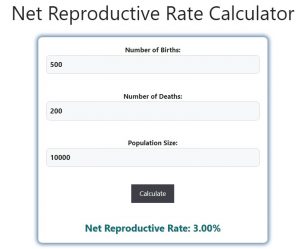About Net Reproductive Rate Calculator (Formula)
The net reproductive rate (NRR) is a vital demographic measure that indicates the average number of daughters a woman would have over her lifetime, considering current age-specific birth and death rates. Understanding the NRR is essential for population studies, as it helps in assessing whether a population is growing or declining. The Net Reproductive Rate Calculator simplifies this calculation, making it accessible for researchers, policymakers, and anyone interested in demographic trends.
Formula
The formula for calculating the net reproductive rate is:
Net Reproductive Rate (NRR) = ((Number of Births – Number of Deaths) / Population Size) * 100
How to Use
Using the Net Reproductive Rate Calculator is straightforward:
- Collect Data: Gather the required data, including the number of births, number of deaths, and the total population size.
- Input Values: Enter the values into the calculator in their respective fields.
- Calculate: Click the calculate button to compute the net reproductive rate.
- Interpret Results: The calculator will provide the NRR, indicating the potential growth or decline of the population.
Example
Consider a population with the following data:
- Number of Births: 500
- Number of Deaths: 200
- Population Size: 10,000
Using the formula:
NRR = ((Number of Births – Number of Deaths) / Population Size) * 100
Substituting the values:
NRR = ((500 – 200) / 10,000) * 100
NRR = (300 / 10,000) * 100
NRR = 3%
In this example, the net reproductive rate is 3%, indicating that, on average, each woman is expected to contribute to a growth of 3% in the population.

FAQs
- What is the net reproductive rate (NRR)?
The NRR measures the average number of daughters a woman would have during her lifetime based on current birth and death rates. - Why is the NRR important?
It helps demographers understand population growth trends and inform policies related to family planning, health care, and resource allocation. - How is NRR different from crude birth rate?
The crude birth rate measures the total number of live births in a year per 1,000 people, while NRR considers both births and deaths. - What does a NRR greater than 1 indicate?
A NRR greater than 1 suggests that the population is growing, as more daughters are being born than the number of deaths. - What does a NRR less than 1 indicate?
A NRR less than 1 indicates a declining population, with fewer daughters born than the number of deaths. - What factors can affect the NRR?
Factors include fertility rates, mortality rates, age structure, and societal influences like health care and education. - How is NRR calculated for a specific age group?
You can calculate age-specific NRR by considering births and deaths within a specific age group and dividing by the population size of that group. - Is NRR the same as the total fertility rate (TFR)?
No, the TFR estimates the average number of children a woman would have in her lifetime without considering mortality. - Can NRR be negative?
No, the NRR can’t be negative; it can be zero or positive but not negative, as that would indicate more deaths than births. - How often should NRR be calculated?
It should be calculated regularly, ideally annually or every few years, to track changes in population dynamics. - What is the significance of a stable NRR?
A stable NRR (around 1) suggests a balanced population, which is crucial for sustainable development and resource management. - Can government policies influence NRR?
Yes, family planning programs, health care access, and educational initiatives can significantly impact birth and death rates, affecting NRR. - How do cultural factors impact NRR?
Cultural beliefs and practices regarding family size and child-rearing can influence birth rates and, consequently, the NRR. - What is the relationship between NRR and population aging?
A declining NRR can lead to an aging population, as fewer young people are born compared to the older population. - How can NRR be used in urban planning?
Urban planners use NRR to predict population changes, which can influence infrastructure, housing, and service needs. - What role does education play in determining NRR?
Higher education levels, particularly among women, often lead to delayed childbirth and lower birth rates, impacting the NRR. - Can NRR be used to compare populations?
Yes, NRR can be used to compare reproductive patterns and population growth between different regions or countries. - What are the limitations of using NRR?
NRR does not account for migration, which can significantly affect population size and dynamics. - How does public health impact NRR?
Improvements in public health can reduce mortality rates, leading to a higher NRR and population growth. - What are the implications of a declining NRR for a country?
A declining NRR may lead to labor shortages, increased dependency ratios, and challenges in supporting an aging population.
Conclusion
The Net Reproductive Rate Calculator is an essential tool for understanding population dynamics. By accurately calculating the NRR, researchers, policymakers, and health officials can make informed decisions regarding family planning, resource allocation, and demographic studies. Monitoring the NRR allows for better preparation for future population trends, ensuring sustainable development and effective social policies.
